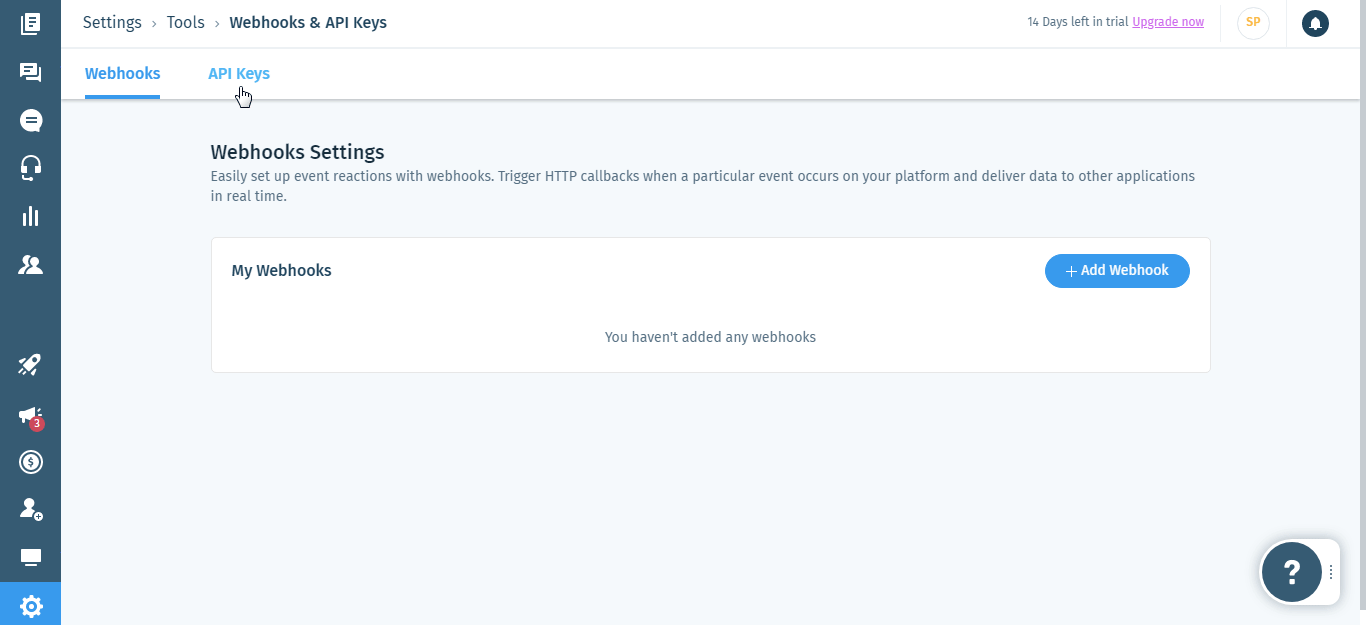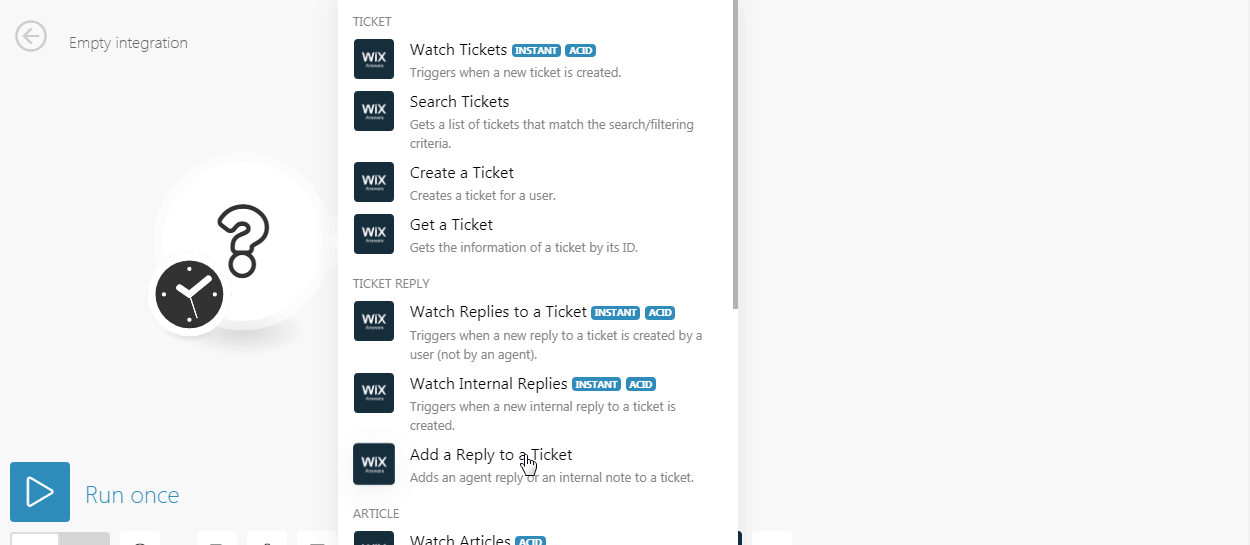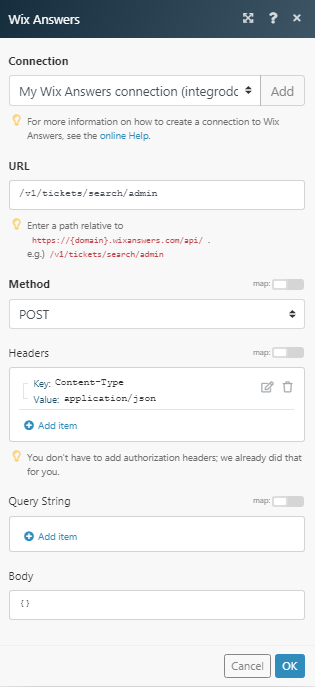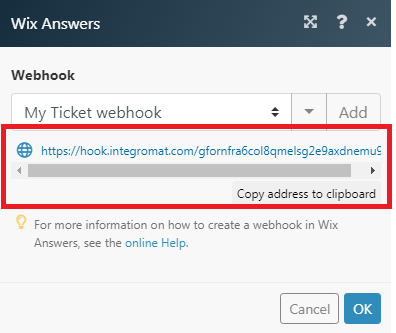| Active with remarks |
|---|
| This application needs additional settings. Please follow the documentation below to create your own connectionUnique, active service acces point to a network. There are different types of connections (API key, Oauth…). More. |
The Wix Answers modulesThe module is an application or tool within the Boost.space system. The entire system is built on this concept of modularity. (module - Contacts) More allow you to watch, create, update, search, and delete tickets, ticket replies, and articles in your Wix Answers account.
Prerequisites
-
A Wix Answers account
In order to use Wix Answers with Boost.spaceCentralization and synchronization platform, where you can organize and manage your data. More IntegratorPart of the Boost.space system, where you can create your connections and automate your processes. More, it is necessary to have a Wix Answers account. If you do not have one, you can create a Wix Answers account at https://www.wixanswers.com/.
![[Note]](https://docs.boost.space/wp-content/themes/bsdocs/docs-parser/HTML/css/image/note.png) |
Note |
|---|---|
|
The moduleThe module is an application or tool within the Boost.space system. The entire system is built on this concept of modularity. (module - Contacts) More dialog fields that are displayed in bold (in the Boost.space Integrator scenarioA specific connection between applications in which data can be transferred. Two types of scenarios: active/inactive. More, not in this documentation article) are mandatory! |
To connect your Wix Answers account to Boost.space Integrator you need to obtain the API Key and API Secret Key from your Wix Answers account and insert it in the Create a connection dialog in the Boost.space Integrator module.
1. Log in to your Wix Answers account.
2. From the left menu, click Settings > WebhooksA webhook is a way for an app to send real-time information to a specific URL in response to certain events or triggers. & API.

3. Click API keys > Add API button.

4. Copy the API Secret Key to your clipboard and click I Saved It.

5. Copy the API Key to your clipboard.

6. Go to Boost.space Integrator and open the Wix Answer module’s Create a Connection dialogue.

7. In the Connection name field, enter a name for the connection.
8. In the Domain field, enter the domain name. For example, if your Wix Answer accessing URL is www.xyz.wixanswers.com, then your domain is xyz.
9. In the API Key field, enter the API Key copied in step 5.
10. In the API Secret Key field, enter the API Secret Key copied in step 4.
11. Click Continue.

The connection has been established.
TriggersEvery scenario has a trigger, an event that starts your scenario. A scenario must have a trigger. There can only be one trigger for each scenario. When you create a new scenario, the first module you choose is your trigger for that scenario. Create a trigger by clicking on the empty module of a newly created scenario or moving the... when a new ticket is created.
Gets a list of tickets that match the search/filtering criteria.
|
Connection |
|
|
Text Search |
Enter the keywords to search for the tickets. |
|
Locale |
Select the language of the article you are searching for. |
|
Filter by UserCan use the system on a limited basis based on the rights assigned by the admin. More With |
Select the option to search for the tickets:
|
|
User Email |
Enter the user email address to filter the article based on the specified email address. |
|
User ID |
Select the user whose articles you are searching for. |
|
Limit |
The maximum number of articles Boost.space Integrator should return during one execution cycleA cycle is the operation and commit/rollback phases of scenario execution. A scenario may have one or more cycles (one is the default).. |
Creates a ticket for a user.
|
Connection |
|
|
Subject |
Enter the subject or topic of the ticket. |
|
Content |
Enter the details of the problem or question. |
|
Locale |
Select the language applicable for the ticket. |
|
Related Article IDs |
Select the articles related to the ticket. |
|
User Email |
Enter the email address of the user who raised the ticket. |
|
User First Name |
Enter the first name of the user. |
|
User Last Name |
Enter the last name of the user. |
|
Priority |
Select the priority of the ticket:
|
|
Assign Agent |
Select the agent to whom the ticket is assigned. |
|
LabelA label is a “tag” that can be added to items within a module. It's a flexible tool used to categorize and organize data, making it easier to customize workflows and processes. More IDs |
Enter the labelsA label is a “tag” that can be added to items within a module. It's a flexible tool used to categorize and organize data, making it easier to customize workflows and processes. More applicable for the ticket. |
Gets the information of a ticket by its ID.
|
Connection |
|
|
Ticket ID |
Select the Ticket ID whose information you want to retrieve. |
Triggers when a new reply to a ticket is created by a user (not by an agent).
|
WebhookA webhook is a way for an app to send real-time information to a specific URL in response to certain events or triggers. name |
Enter a name for the webhook. |
|
Connection |
Triggers when a new internal reply to a ticket is created.
|
Webhook name |
Enter a name for the webhook. |
|
Connection |
Adds an agent reply or an internal note to a ticket.
Triggers when a new article is created or updated.
|
Connection |
|
|
Watch Article |
Select the option to watch the articles:
|
|
Locale |
Select the language of the articles you want to watch. |
|
Limit |
The maximum number of articles Boost.space Integrator should return during one execution cycle. |
Searches for articles that fulfill the search/filtering.
|
Connection |
|
|
Locale |
Select the language of the articles you want to search for. |
|
Text Search |
Enter the text to search the articles based on the phrases. |
|
Category ID |
Select the Category ID of the articles you were searching for. For example, Getting Started, FAQs |
|
Include Any Label ID |
Enter the Label ID to search the articles based on the labels. |
|
Limit |
The maximum number of articles Boost.space Integrator should return during one execution cycle. |
Returns an article by ID per locale.
|
Connection |
|
|
Locale |
Select the language of the article whose information you want to retrieve. |
|
Article ID |
Select the Article whose information you want to retrieve. |
Creates a new article and returns the newly created article.
|
Connection |
|
|
Locale |
Select the language of the article which you are creating. |
|
Category ID |
Select the applicable category for the article. For example, FAQ. |
|
Type |
Select the article type you want to create:
|
|
Title |
Enter a name for the article. |
|
Content |
Enter the article text. |
|
StatusCreate statuses for each module separately to create an ideal environment for efficient and consistent work. More |
Select the status of the article:
|
Updates the article’s title, content, and automatically publishes the changes by making those changes visible to users.
|
Connection |
|
|
Locale |
Select the language of the article which you are creating. |
|
Article ID |
Select the article you want to update. |
|
Title |
Enter a name for the article. |
|
Content |
Enter the article text. |
Performs an arbitrary authorized API call.
![[Note]](https://docs.boost.space/wp-content/themes/bsdocs/docs-parser/HTML/css/image/note.png) |
Note |
|---|---|
|
To search the articles or tickets, use the POST method. |
|
Connection |
||||
|
URL |
Enter a path relative to
|
|||
|
Method |
Select the HTTP method you want to use: GET to retrieve information for an entry. POST to create a new entry. PUT to update/replace an existing entry. PATCH to make a partial entry update. DELETE to delete an entry. |
|||
|
Headers |
Enter the desired request headers. You don’t have to add authorization headers; we already did that for you. |
|||
|
Query String |
Enter the request query string. |
|||
|
Body |
Enter the body content for your API call. |
The following API call returns all the tickets from your Wix Answers account.
URL: /v1/tickets/search/admin
Method: POST
Body: {}

Matches of the search can be found in the module’s Output under BundleA bundle is a chunk of data and the basic unit for use with modules. A bundle consists of items, similar to how a bag may contain separate, individual items. More > Body > itemsItems are rows in records (order/request/invoice/purchase...). In our example, 1 itemItems are rows in records (order/request/invoice/purchase...) was returned:

1. Create a webhook using the Wix Answers instant triggerEvery scenario has a trigger, an event that starts your scenario. A scenario must have a trigger. There can only be one trigger for each scenario. When you create a new scenario, the first module you choose is your trigger for that scenario. Create a trigger by clicking on the empty module of a newly created scenario or moving the... module dialog.

2. In the Webhook Name field, enter a name for the webhook.
3. Establish a connection to the webhook. See Connecting Wix Answers to Boost.space Integrator. Click Save.

4. Copy the webhook URL to your clipboard.

6. Login to your Wix Answers accounts and click Settings > Webhooks & API.

7. Click Add Webhook.

8. Create a webhook by entering the following details.

-
What’s the name of your webhook?: Enter a name for the webhook.
-
What’s the URL you want to send POST requests to?: Enter the URL copied in step 4.
-
What action triggers the event?: Select the event you want the webhook to trigger
Click Create.
The webhook is successfully created and you will receive triggers when the specified event happens.

